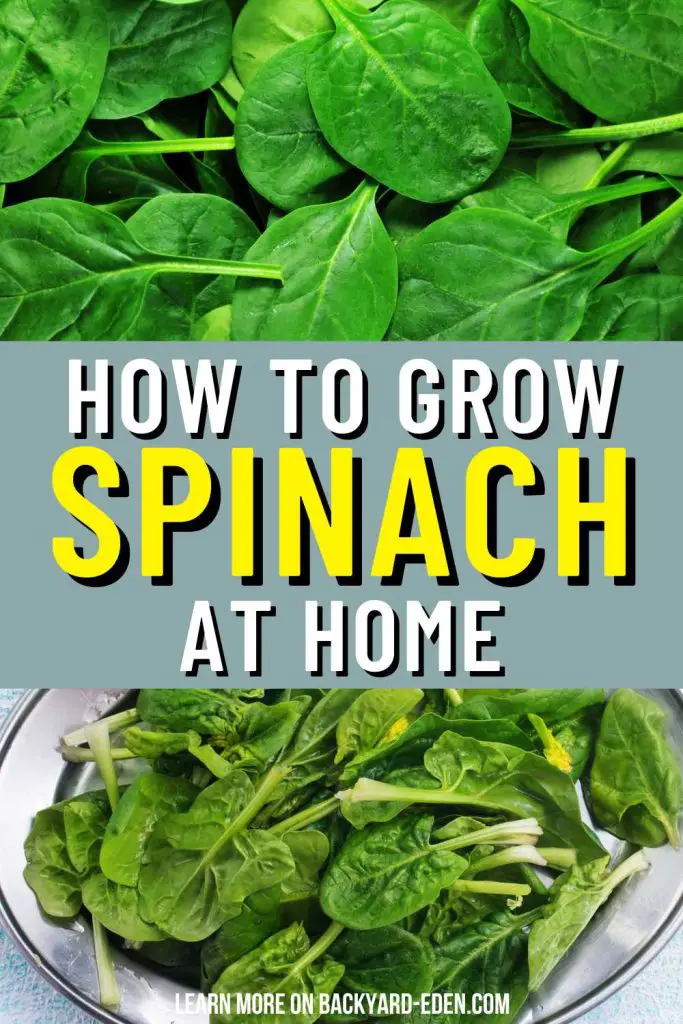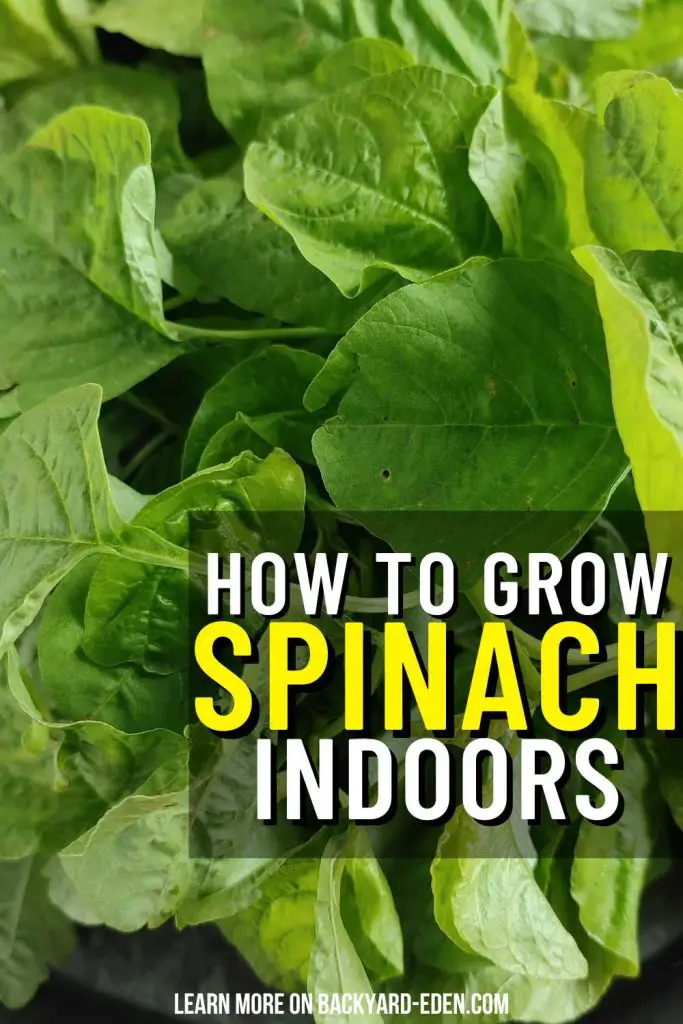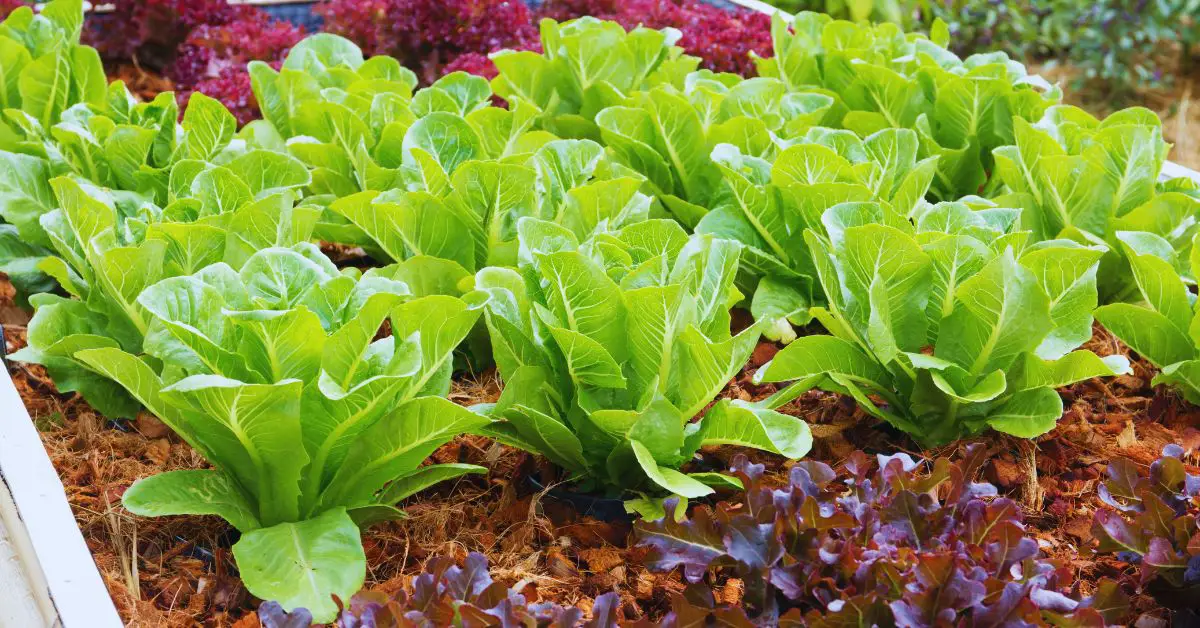Growing spinach indoors is an exciting way to ensure a steady supply of fresh greens throughout the year. Perfect for gardeners living in apartments or those facing harsh winters, indoor spinach cultivation offers a simple solution to grow your own nutritious vegetables without stepping outside.
This guide will detail the steps from seed selection to harvest, making it easy for anyone to start their indoor spinach garden.
Whether you’re a seasoned gardener or a beginner, you’ll find that growing spinach inside is rewarding and straightforward, providing you with leafy greens whenever you crave them.

This post may contain affiliate links. Read our full disclosure here.
Why Grow Spinach Indoors?
Year-Round Harvest
Indoor gardening breaks the boundaries of seasons, allowing you to harvest spinach year-round. This continuous supply means you can enjoy fresh, home-grown spinach in salads, smoothies, and dishes at any time, regardless of the weather outside.
Space Efficiency
Spinach is notably space-efficient, thriving in smaller containers that fit perfectly on windowsills, countertops, or indoor garden shelves. This compact nature makes it an ideal choice for indoor environments where space might be limited.
Control Over Environment
Growing spinach indoors gives you complete control over the growing conditions. This includes managing light exposure, watering schedules, and temperature, ensuring your spinach grows in optimal conditions away from outdoor pests and diseases.
By choosing to grow spinach inside, you not only gain access to fresh greens all year but also enjoy the gardening process in a controlled, convenient setting. This method is perfect for those looking to maximize their space and have fresh spinach at their fingertips, no matter the season.
Selecting Spinach Seeds
Choosing the right seeds is the first step in your indoor spinach growing journey. Here’s what to consider:
Variety Matters
Opt for spinach varieties that are well-suited for indoor cultivation. Varieties like ‘Baby Leaf,’ ‘Space,’ and ‘Tyee’ are known for their compact growth and suitability for container gardening. These varieties can thrive under indoor conditions and provide a bountiful harvest.
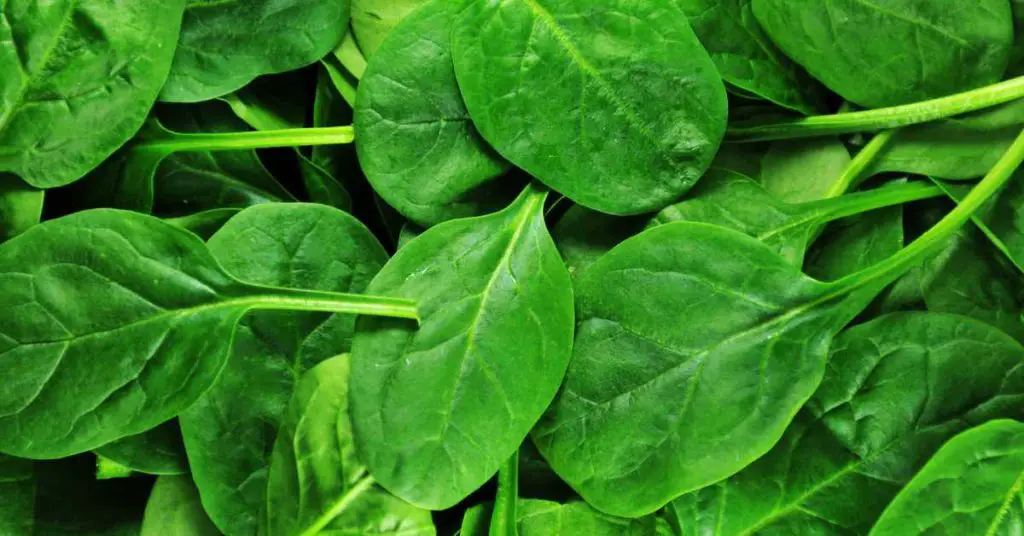
Organic Seeds
Using organic seeds ensures that your spinach is free from synthetic chemicals and genetically modified organisms (GMOs). Organic seeds come from plants that have been grown according to organic farming standards, which support healthy soil and ecosystems.
Selecting the right spinach seeds is crucial for successful indoor gardening. By choosing the right variety and opting for organic seeds when possible, you set the foundation for a healthy and productive indoor garden that will provide you with nutritious greens.
Preparing Your Indoor Garden
Setting up the right environment for your spinach plants is key to their growth and productivity. Here’s how to prepare your indoor garden:
Containers
Choose containers that are 6-8 inches deep to accommodate the root system of spinach plants. Ensure they have adequate drainage holes to prevent waterlogged soil, which can lead to root rot.
Soil
Fill your containers with a high-quality organic potting mix. Spinach prefers well-draining soil rich in organic matter. Avoid using garden soil, as it can contain pests and diseases and may not provide the right drainage and aeration for container gardening.
Light
Spinach requires 12-14 hours of light each day to thrive. A sunny windowsill can be ideal, but in many indoor environments, supplemental lighting from grow lights may be necessary to meet the plant’s light needs.
Temperature
Spinach grows best in cool temperatures, between 60-70°F (15-21°C). Avoid placing your plants near heat sources or in areas where temperatures fluctuate widely, as this can stress the plants and affect their growth.
By carefully selecting the right containers, soil, and ensuring adequate light and temperature, you create an optimal growing environment for your indoor spinach. This preparation is crucial for healthy plants and bountiful harvests.
Planting Your Spinach
Once your indoor garden is set up, it’s time to plant your spinach seeds. Here’s the process for getting your seeds started:
Sowing Seeds
- Depth: Plant your spinach seeds about ½ inch deep in the soil.
- Spacing: Space the seeds approximately 2-3 inches apart to give each plant enough room to grow. If you’re planting rows, keep them 6-8 inches apart.
- Moisture: After sowing, water the soil gently but thoroughly to moisten it without disturbing the seeds.
Watering
Spinach needs consistent moisture to germinate and grow. Keep the soil evenly moist but not soggy. Using a spray bottle to mist the soil can prevent over-watering and soil disturbance.
Germination
- Time: Spinach seeds typically germinate within 5-14 days, depending on the variety and growing conditions.
- Temperature: A cooler temperature within the 60-70°F (15-21°C) range is ideal for germination.
Thinning Seedlings
Once the seedlings have emerged and have grown a couple of true leaves, thin them out so that the strongest plants are about 3-4 inches apart. This reduces competition for light, water, and nutrients.
Planting your spinach with the right technique and care sets the stage for a healthy growing period. Regular attention to watering and thinning will ensure your spinach plants develop well and are ready for a bountiful harvest.
Caring for Your Spinach Plants
Proper care is crucial for your indoor spinach to thrive and produce a generous yield. Here’s how to ensure your plants get the attention they need:
Watering
Spinach prefers consistent moisture. Water your plants when the top inch of soil feels dry to the touch, ensuring the soil is moist but not waterlogged. Over-watering can lead to root diseases, while under-watering can stress the plants and affect leaf production.
Feeding
About a month after planting, begin feeding your spinach with a half-strength, balanced, water-soluble fertilizer every two weeks. Spinach isn’t a heavy feeder, but a little nutrition boost can help support leaf production, especially if you notice growth slowing.
Light Management
If you’re using grow lights, adjust them to remain about 2-4 inches above the tops of the plants, raising the lights as the plants grow. This ensures that your spinach receives enough light without getting scorched.
Temperature Control
Keep the growing environment cool, ideally between 60-70°F (15-21°C). If your indoor space gets warmer, consider using a fan for airflow or moving your plants to a cooler location during the hottest part of the day.
Pest and Disease Watch
While growing indoors significantly reduces the risk of pests and diseases, always be vigilant. Watch for signs of common indoor plant pests like aphids and treat any issues promptly with organic pest control methods. Keeping your growing area clean and your plants healthy is the best defense.
Caring for your indoor spinach involves consistent watering, occasional feeding, and managing light and temperature to mimic the plant’s natural growing conditions as closely as possible. With the right care, your spinach will grow lush and leafy, ready for harvest in just a few weeks.
Harvesting Your Spinach
Harvesting spinach at the right time ensures you get the most flavorful and tender leaves. Here’s how to harvest your indoor spinach for the best results:
When to Harvest
- Timing: Spinach is ready to harvest as soon as the leaves are big enough to eat, typically about 4-6 weeks after planting.
- Size: Aim to pick leaves when they are about 3-6 inches long. Harvesting smaller leaves will result in a more tender and flavorful crop.
How to Harvest
- Method: Gently snip or pinch off the outer leaves at the base of the plant, allowing the inner leaves to continue growing. This method encourages the plant to produce more leaves for a continued harvest.
- Continuous Harvest: By regularly harvesting the outer leaves, you can extend the productivity of your plant and enjoy fresh spinach over a longer period.
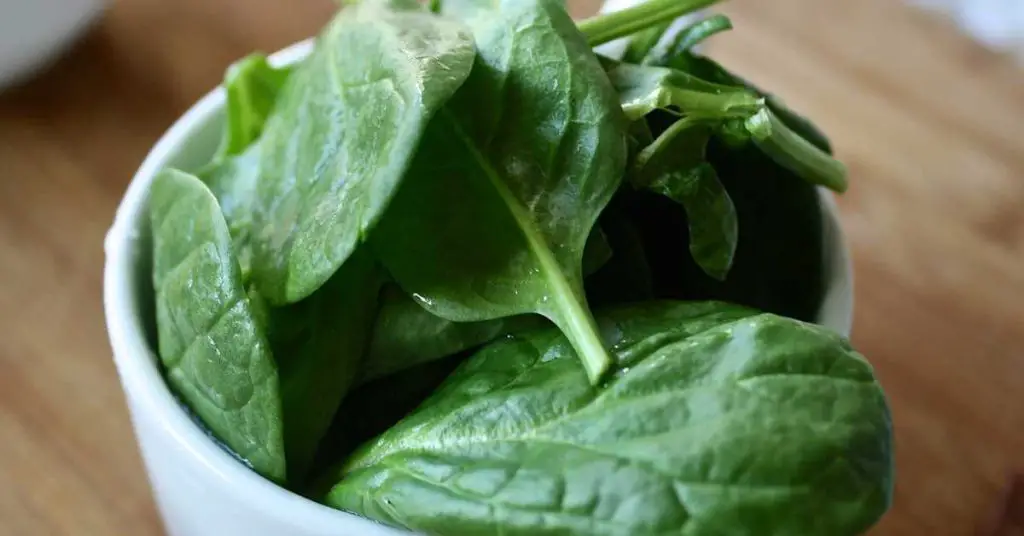
Post-Harvest Care
- Washing: Rinse the harvested leaves in cold water to remove any soil or debris. Spinach can be gritty, so a thorough wash is recommended.
- Storing: Spinach is best enjoyed fresh but can be stored in the refrigerator for a few days. Wrap the leaves in a paper towel and place them in a plastic bag to maintain freshness.
Harvesting your spinach correctly not only maximizes yield but also ensures that each leaf is at its peak of flavor and texture. Whether you’re adding fresh spinach to a salad, incorporating it into recipes, or enjoying it as a stand-alone side, the freshness of homegrown spinach is unmatched. With regular harvesting, your indoor spinach plants can provide a bountiful supply of greens for your culinary creations.
FAQ
Can You Grow Spinach Indoors All Year?
Yes, you can grow spinach indoors all year round. One of the great advantages of indoor gardening is the ability to control the environment, regardless of the season.
By providing your spinach plants with consistent light, temperature, and moisture, you can cultivate fresh greens at any time of the year. This continuous harvest ensures that you always have access to fresh spinach for your meals.
Does Spinach Grow Well Indoors?
Spinach does indeed grow well indoors, thanks to its relatively simple care requirements and adaptability. With adequate light (natural or artificial), the right soil mix, and proper watering, spinach can thrive in an indoor setting.
Its compact size and fast-growing nature make it an ideal candidate for indoor vegetable gardening, producing a bountiful harvest in a small space.
How Long Does Spinach Take to Grow in Pots?
Spinach grown in pots typically reaches harvest size about 4-6 weeks after planting. This quick growth cycle makes it an excellent choice for indoor gardening, offering rapid rewards for your efforts.
The key to success is ensuring the pots have good drainage and are filled with a quality potting mix, along with providing sufficient light and maintaining a cool, stable temperature.
How Do You Grow Spinach Indoors Under Lights?
To grow spinach indoors under lights, you’ll need a grow light setup that can provide around 12-14 hours of light per day. Position the lights about 2-4 inches above the spinach plants, adjusting the height as the plants grow to avoid burning the leaves.
LED or fluorescent grow lights are both suitable options that mimic the spectrum of natural sunlight, encouraging healthy growth and leaf production in your spinach plants.
How Long Does It Take Spinach to Sprout Indoors?
Spinach seeds typically sprout indoors within 5-14 days after planting, depending on the variety and growing conditions. To encourage germination, keep the soil moist but not waterlogged, and maintain a consistent temperature within the ideal range of 60-70°F (15-21°C).
Proper soil moisture and temperature are crucial for encouraging your spinach seeds to sprout successfully indoors.
Conclusion
Growing spinach indoors is a rewarding activity that lets you enjoy fresh greens year-round. This guide has shown you how to start from seed selection to enjoying a bountiful harvest.
Indoor spinach gardening is straightforward, needing only consistent light, moisture, and care to thrive.
Enjoy the freshness and nutritional benefits of home-grown spinach in your dishes, and use this experience to explore more indoor gardening opportunities.

